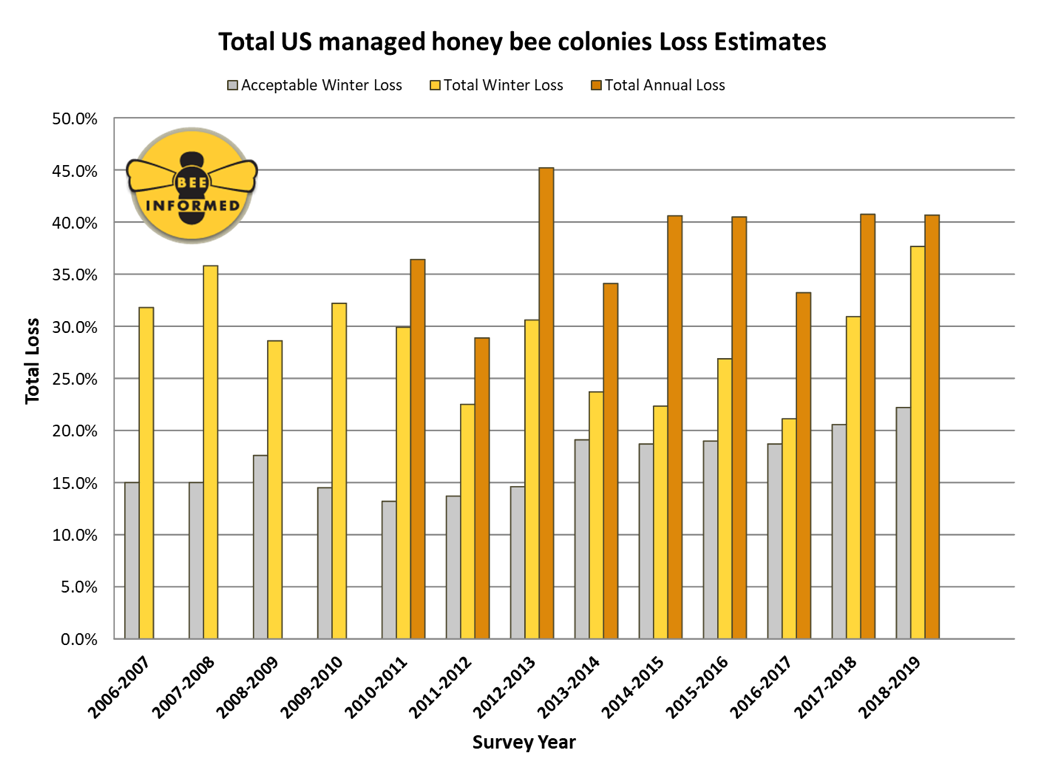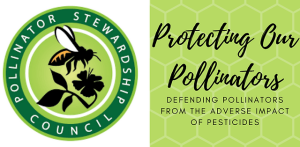You might have been wondering when the preliminary results of the 2018/9 Bee Informed Partnership Colony Loss and Management Survey will be posted.
Well, today is the day. Thanks for your patience!
The “traditional” abstract is below, while the Press Release issued by the University of Maryland can be read here.
We want to thank all of you – whether you are a long-term respondent or a new-Bee to the survey – for participating this year. The information you provided is critical to building a long-term data set that we can now use to develop regionally-specific management recommendations.
Please keep your eyes on our national colony loss map and our interactive management portal. In the coming weeks we will be publishing our 2018/19 state-specific results.
Fig 1. Total winter colony loss rate in the United States across years of the Bee Informed Partnership’s National Honey Bee Colony Loss Survey (yellow bars; 1 October – 1 April)1. Total annual loss estimates (orange bars) include total winter and summer (1 April – 1 October) losses; the latter has been estimated since 2010-2011 only. The acceptable winter loss rate (grey bars) is the average percentage of acceptable winter colony loss declared by the survey participants in each year of the survey.
1Previous survey results estimated total winter colony loss values of 31% in the winter of 2017-18, 21% in 2016-17, 27% in 2015-16, 22% in 2014-15, 24% in 2013-14, 30% in 2012-13, 22% in 2011-12, 30% in 2010-11, 32% in 2009-10, 29% in 2008-09, 36% in 2007-08, and 32% in 2006-07 (see reference list).
The Bee Informed Partnership (BIP; http://beeinformed.org) recently conducted the 13th annual survey of managed honey bee colony losses in the United States. This past year, 4,696 beekeepers collectively managing 319,787 colonies as of October 2018 provided validated colony loss survey responses. The number of colonies managed by surveyed respondents represents 11.9% of the estimated 2.69 million managed honey-producing colonies in the nation (USDA, 2018).
During the 2018-2019 winter (1 October 2018 – 1 April 2019), an estimated 37.7% of managed honey bee colonies in the United States were lost (Fig. 1). This loss represents an increase of 7 percentage points compared to last year (30.7%), and an increase of 8.9 percentage points compared to the 13-year average winter colony loss rate of 28.8%. This year’s estimate is the highest level of winter losses reported since the survey began in 2006-2007.
Similar to previous years, backyard beekeepers lost more colonies over the winter (39.8%) compared to sideline (36.5%) and commercial (37.5%) beekeepers. Backyard, sideline, and commercial beekeepers are defined as those managing 50 or fewer colonies, 51 to 500 colonies, and 501 or more colonies, respectively.
Our survey also asked what level of winter loss would be acceptable by beekeepers. Interestingly, this revealed an increase from 20.6% last year to 22.2% this year, which is much greater than the 11-year average of 17%. This increased acceptable loss may indicate that beekeepers are more realistic or pragmatic in their expectations of colony losses. Even with a higher acceptable loss, sixty-two percent of responding beekeepers lost more colonies than the level deemed acceptable.
During the summer 2018 season (1 April 2018 – 1 October 2018), an estimated 20.5% of managed colonies were lost in the U.S. This level is slightly higher (3.4 percentage points) than the previous summer’s colony loss estimate of 17.1%, but is on par with the summer loss average reported by beekeepers since 2010-2011 (20.5%), when summer losses were first recorded by the BIP.
For the entire survey period (1 April 2018 – 1 April 2019), beekeepers in the U.S. lost an estimated 40.7% of their managed honey bee colonies. This is similar to last year’s annual loss estimate of 40.1%, but slightly higher (2.9 percentage points) than the average annual rate of loss reported by beekeepers since 2010-11 (37.8%).
We note that loss rate for each period was estimated by identifying the total number of at-risk-colonies that died, and that annual loss rate was not estimated by summing the individual summer and winter loss rates. This year’s state-specific loss rates will be added to previous years’ results on the BIP website shortly (https://bip2.beeinformed.org/loss-map/).









